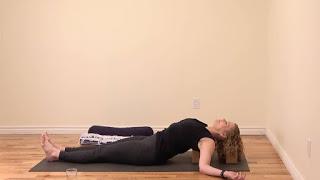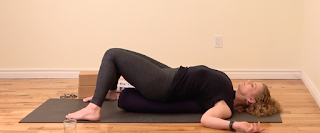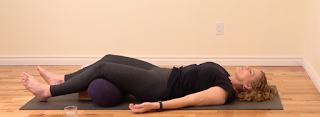by Barrie

Quiet pond in the park of Appeal by Gustav Klimt
By now, I realize it might be overstating the obvious to say that your mind and sensory awareness can get drained from extensive online engagement, not just mentally but physically as well. Interacting with others through a screen is taxing on your nervous system on many different levels.
Pranayama and pratyahara are related practices that turn our awareness inward and direct the mind and senses back toward their source. Together, they are an ideal way to give your body and mind a rest and reset.
Pratyahara is the fifth limb of Patanjali’s eight-limb system. It’s defined as the withdrawal of the senses. It’s really the key to yoga’s power of renewal. Yoga teacher Donna Farhi defines pratyahara as, “The movement of the mind toward silence, rather than toward things.”
Traditional yogic texts say that where the mind goes the senses will follow, like bees following their queen. One of the main ways that yoga works to clear and refresh our minds is by redirecting our attention and particularly our senses—which normally move outward to interact with the world around us—back inside to their source, where they can rest. Not unlike our devices, our mind and senses also need to connect to their power source, which is nothing other than our own inner being, and regularly recharge.
This is the benefit of pratyahara, turning the mind and the senses inward toward their source where they are replenished and renewed. For this reason, in addition to simply being relaxing, yoga practiced in a quiet, inward way can also be deeply refreshing and reinvigorating.
While it can sometimes feel challenging to focus the mind inside, it that can help immensely is to have an inner object of focus, something to rest the mind on. The breath is ideal for this. That’s where pranayama comes in.
Pranayama, literally the expansion of prana, the vital energy, is the fourth of Patanjali’s eight-limb system. It comes before pratyahara. In this way we can think about the relationship between the two as one leading into the other, the attention and focus on breath as supporting and naturally resulting in the withdrawal of the senses inward.
Breath and attention are completely interrelated in yoga. They are different forms of prana, the vital force. They are the same energy in different forms and having different functions.
Therefore, where the breath goes, the mind naturally follows. This is why although technically we only breathe in the lungs, if we’re relaxed and mindful, we can send and feel the breath moving in different parts of the body—our arms, our feet, our back, and so on.
The following simple sequence combines restorative postures, breath work, and Savasana. This practice is particularly suited for the end of a day of online engagement as a way of resting for a little while before transitioning into the rest of your day or evening. Think of it as an opportunity to get quiet, give yourself the gift of pause, and plug into your inner wellspring of renewal and rejuvenation.
If possible, be in a dark, quiet, and warm place for this practice. You’ll need the following props:
- 2 blocks
- 1 blanket
- 1 bolster (or folded blankets if you don’t have a bolster)
- Eye pillow (optional)
Practicing this sequence in full will take between 35 and 50 minutes. If you’re short on time, there’s an abbreviated 20-minute version at the end of this post.
1. Supported Backbend (Paryankasana) over two blocks or a blanket roll for 3-5 minutes minutes.

Lie over two blocks at either their lowest height or medium height. Place one at the base of your shoulder blades and the other under the back of your head. Place your arms out to the sides or slightly lower if that is more comfortable for you.
2. Supported Bridge pose (Setu Bandha) with bent knees over bolster for 5-10 minutes.

Begin by lying on a bolster. Then, gently slide off the bolster until the back of your head and the tops of your shoulders touch the floor. Adjust your positioning so that your back feels comfortable. Keep your knees bent and your feet flat on the floor. Place your arms in a cactus position (elbows bent) or arms straight and out to the sides.
3. Pranayama in Corpse pose (Savasana) with knees over bolster and block.

For this practice, you’ll be doing three different forms of pranayama:
- Full Yogic Breath for 8-10 minutes: See detailed instructions below.
- Balanced Breathing (Sama Vrtti Pranayama) for 3-5 minutes: See detailed instructions below.
- Lengthening the Exhalation (Vishama Vrtti Pranayama) for 3-5 minutes: Make your exhalation 1 or 2 counts longer than your inhalation. If it feels more easeful, you can shorten the length of your inhalation by 1 or 2 counts instead. For more detailed instructions, see Calming Breathing Practices We Recommend.
4. Final Corpse pose (Savasana) with bent knees over bolster (as above) for 12-15 minutes.
Three-Part Breath Instructions
The full yogic breath, sometimes also known as the three-part breath, is an exercise in experiencing the full range of our natural, diaphragmatic breathing. In the first phase, you focus on the effects of the breath in the lower belly. This can release and soften the abdominal organs, allowing for the full downward movement of the diaphragm. In the second phase, you bring awareness to the midsection by focusing on the movement of the ribcage and the lateral (sideways) and posterior movements (toward your back) of the diaphragm. In the final phase, you bring awareness to the top of the chest in order to breathe with the fuller capacity of your lungs.
Part 1 (2-3 minutes):
1. Begin by getting comfortable. Soften anywhere in your body you don’t need to be holding. Enjoy the natural movement of your breathing.
2. Place your hands on your belly below your navel to form a V shape by touching your thumbs together and pointing your outstretched fingers downward.
3. Inhale through your nose and feel your abdomen filling like a balloon, gently moving up into your hands.
4. Exhale through your nose and feel your belly softening back down.
Part 2 (2-3 minutes):
1. Place your hands on the sides of your ribcage, above your waistline, with your fingers pointing in toward each other. Make sure your shoulders, arms and hands stay relaxed.
2. As you breathe in, feel your ribs moving out to the sides and slightly upwards, sensing the sideways movement of your breath. You may also feel the movement of your breath in the back of your body.
Part 3 (2-3 minutes):
1. Place your hands lightly on the top of your chest just below your collarbones, forming an upside-down V shape with the fingers touching.
2. Breathing in, feel your upper chest slightly lift under your hands. You may also feel the effect of your breath in your shoulder girdle and neck.
3. Breathing out, feel your upper chest soften back down.
Part 4 (2-3 minutes):
1. To practice the complete three-part breath, place one hand in the first position, on your low belly, and the other hand on your upper chest.
2. Following an exhalation, begin by filling your breath from bottom to top. Fill slowly, as if you were pouring water into a pitcher, allowing your breath to fill the front, sides, and back of your body as you breathe in.
3. Exhale slowly, emptying your breath in the same order that you inhaled, from the bottom first, then the middle, then the top.
4. When you finish practicing Three-Part Breath, return to your natural breath for a minute or two.
Balanced Breathing (Sama Vrtti Pranayama) Instructions
In this exercise, you make your inhalation and exhalation the same duration.
1. Focus your attention on the natural rhythm your inhalation and your exhalation. Become aware of the transition between your inhale and the exhale as well.
2. Begin inhaling to a comfortable count of 4, and exhaling out to a comfortable count of 4, with a short pause between the breaths. If the count of 4 feels too long or too short, you can adjust as needed for it to feel comfortable, keeping your inhale and the exhale the same length.
3. Maintain a sense of relaxation and ease throughout this exercise, allowing your breath to flow gently and smoothly.
4. Continue breathing in and out to the count you have selected, with a short pause between your exhalation and your next inhalation.
5. After a little while, you may notice your inhalations and exhalations naturally want to lengthen. You may want to go to a higher count as you continue.
6. When you finish practicing Balanced Breathing, return to your natural breath for a minute or two.
For more detailed instructions see Breath Practices for Balance.
Shorter Timings for Poses and Practices
1. Supported Backbend (Paryankasana) over two blocks or a blanket roll for 2-3 minutes.
2. Supported Bridge pose (Setu Bandha) with bent knees over bolster for 2-3 minutes.
3. Pranayama in Corpse pose (Savasana) with knees over bolster and block (return to natural breathing for a few rounds in between):
- Three-Part Breath for 3-5 minutes - each part for 30 seconds-1 minute and then full exercise for 2-3 minutes.
- Balanced Breathing (Sama Vrtti Pranayama) for 2-3 minutes.
- Lengthening the Exhalation (Vishama Vrtti Pranayama) for 2-3 minutes.
4. Final Corpse pose (Savasana) with bent knees over bolster (as above) for 8-10 minutes.
Download Barrie’s free Guide to Home Yoga Practiceright here. Learn more about her book Evolving Your Yoga: Ten Principles for Enlightened Practice and her online classes at www.barrierisman.com
Subscribe to Yoga for Healthy Aging by Email ° Follow Yoga for Healthy Aging on Facebook ° To order Yoga for Healthy Aging: A Guide to Lifelong Well-Being, go to Amazon, Shambhala, Indie Bound or your local bookstore.

